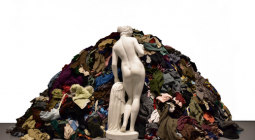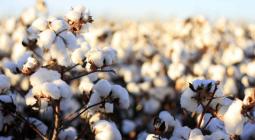Even though the company now uses a variety of plastics, multicolored party cups still make up most of the raw materials in its own line. The items’ pink, blue and green pastel hues come from the cups themselves rather than added dyes. Choi said her yarn is made from continuous filaments, rather than fibers that are spun together, which means it’s less likely to shed harmful microplastics.
The New Norm is still a lean operation: Choi, who recently moved to Boston to pursue an MBA at the Massachusetts Institute of Technology, said at any given time there are between three and 25 people working at the company. She declined to share sales figures, but said that in the last two years production had expanded from tens of pounds per run to thousands.
Choi said she aims to expand the business-to-business side of The New Norm, which she sees as offering the biggest opportunity for an environmental impact.
“From the beginning, our goal has been to get to a place where we can scale production and work with really large brands who are using significant quantities of materials,” she said. The New Norm is undergoing pilots with large brands, testing everything from the strength of the yarn to how well it launders, with the goal of developing and selling the material at a much larger scale.
This aligns with where some experts see the industry going, as a growing number of companies rethink where they source their raw materials. One report found that the sustainable textile market was valued globally at $29.5bn in 2024, and is expected to hit $71bn by 2031. (While what constitutes “sustainable” is somewhat nebulous, most research defines it as textiles made with eco-friendly material, including recycled fibers, which minimize water, chemicals, and carbon emissions.)
For her part, Choi hopes The New Norm can put a dent in the global plastics crisis, which has reached disastrous levels. The world produces 200 times as much plastic today as it did in 1950, less than 10% of which is recycled. There’s an estimated 8bn tons of plastic pollution across the globe, and just three plastic chemicals cause as much as $1.5tn in annual health costs.
Cox said Choi was early in terms of thinking about how to transform plastic into textile. And while there are other companies that turn plastic and textile waste into yarn, Cox said Choi’s focus on the party cup was unique, especially because of where it could lead. “Food containers, food packaging, that’s something that we don’t think about,” she said. “Everyone throws it out daily, and there haven’t been many solutions.”
Some might question if we really want to be wearing clothes made out of plastic, but the reality is we already are. More than 60% of fibers produced worldwide are synthetic, the vast majority of which are derived from virgin fossil fuels, according to a 2024 report from Textile Exchange, making the fashion industry a major contributor to greenhouse gas emissions. Cox and Choi both acknowledged how much needs to be done to reduce plastic usage, but see upcycling as an important first step.
“It would be amazing if we lived in a plastic-free world,” Choi said. “But if you look at the volume of virgin, synthetic fibers made annually, we’re talking billions of tons of material. There’s a long road to go.”




